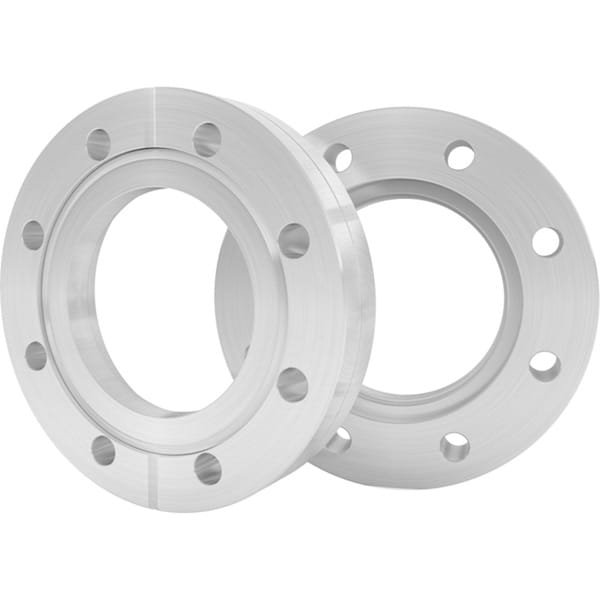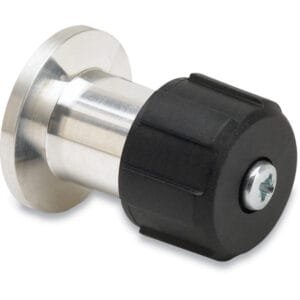Rotatable-Bored 316LN SS Standard ConFlat® (CF) UHV Flanges
Rotatable-Bored 316LN SS Standard ConFlat® (CF) UHV Flanges are advanced components used to create leak-tight, ultra-high vacuum (UHV) seals in vacuum systems that require flexible alignment. These flanges are made from 316LN stainless steel, offering exceptional resistance to corrosion and ensuring long-lasting performance in demanding applications. Ideal for industries such as semiconductor processing, research, and material science, these flanges offer the perfect solution for maintaining the integrity of UHV systems.
Key Features
Material: Constructed from 316LN stainless steel, a material known for its excellent corrosion resistance, high tensile strength, and low outgassing properties, which are critical for UHV applications.
Rotatable-Bored Design: The rotatable-bored feature allows the flange to be adjusted in orientation after installation. This provides flexibility in aligning the connected components, making it easier to integrate into existing systems or for precise positioning within a vacuum setup.
ConFlat® Seal: The ConFlat® (CF) seal uses a metal-to-metal interface for an airtight seal. This design ensures exceptional vacuum integrity, preventing leaks even in high-demand environments.
Standard Dimensions: These flanges conform to the standard ConFlat® (CF) flange dimensions, ensuring compatibility with other CF components and ease of integration into vacuum systems.
Bored Configuration: The flange comes with a bored hole, making it ideal for connecting to vacuum chambers, pumps, and other equipment, while maintaining the seal and integrity of the vacuum system.
High Purity and Durability: 316LN stainless steel ensures the flange maintains its strength and corrosion resistance over extended periods, even in aggressive environments or high-temperature applications.
Applications
Flexible System Integration: Perfect for systems where component alignment needs to be adjustable without compromising the vacuum integrity. Ideal for research and semiconductor applications where precise alignment is crucial.
Semiconductor Manufacturing: Used extensively in semiconductor processing, including deposition, etching, and thin-film applications, where maintaining a consistent vacuum environment is critical.
Research Laboratories: Essential in scientific research and high-energy physics experiments, where ultra-high vacuum conditions are required for particle accelerators, electron microscopy, and other precision instruments.
Custom Vacuum Systems: A versatile solution for custom vacuum system setups where multiple components need to be connected with flexible alignment, ensuring easy integration into complex configurations.
Material Science: Employed in material testing environments that require controlled vacuum conditions for thin-film deposition or other sensitive processes.
Why Choose TFM’s Rotatable-Bored 316LN SS Standard ConFlat® (CF) UHV Flanges?
Superior Material: 316LN stainless steel provides excellent corrosion resistance, high strength, and low outgassing, which is essential for maintaining stable, clean vacuum environments.
Rotatable Design: The ability to rotate and adjust the flange orientation after installation allows for more flexibility when aligning equipment and components in your UHV system.
Leak-tight Performance: The ConFlat® metal-to-metal seal ensures a robust, leak-tight connection, making it ideal for applications where vacuum integrity is critical.
Customizable: Available in a variety of sizes and configurations, these flanges can be customized to fit specific application requirements, whether in semiconductor, research, or industrial applications.
Compatibility with CF Components: These flanges conform to ConFlat® dimensions, ensuring they are compatible with a wide range of other CF components, making them easy to integrate into existing vacuum systems.
Durability and Long-Lasting Performance: Manufactured using high-quality materials and processes, these flanges are designed for extended use, offering durability and long-term reliability in demanding vacuum conditions.
Manufacturing Process
Cold Pressing and Sintering: The flanges are manufactured using a cold-pressing process followed by sintering, resulting in high-density components with uniform properties.
Elastomer Bonding: Elastomer bonding is used to attach the flange to a backing plate, enhancing the overall strength and durability of the flange under vacuum conditions.
Thorough Cleaning: Each flange is thoroughly cleaned before packaging to remove contaminants, ensuring that the flange is ready for immediate use in sensitive vacuum applications.
Careful Packaging: The flanges are carefully packaged to protect them from damage and environmental contaminants during shipping, ensuring they reach customers in optimal condition.
Ordering Table
Rotatable-Bored 316LN SS Standard ConFlat® (CF) UHV Flanges
| Flange Size/OD | Type | Note | Part Number |
| DN16CF (1.33" OD) | Rotatable | — | F0133N075RLN |
| DN35CF-DN40CF (2.75" OD) | Rotatable | — | F0275N100RLN |
| DN35CF-DN40CF (2.75" OD) | Rotatable | — | F0275N150RLN |
| DN35CF-DN40CF (2.75" OD) | Rotatable | — | F0275N162RLN |
| DN35CF-DN40CF (2.75" OD) | Rotatable | — | F0275N175RLN |
| DN63CF (4.50" OD) | Rotatable | — | F0450N250RLN |
| DN63CF (4.50" OD) | Rotatable | — | F0450N275RLN |
| DN75CF (4.63" OD) | Rotatable | F0462N300RLN | |
| DN75CF (4.63" OD) | Rotatable | F0462N300RLN | |
| DN75CF (4.63" OD) | Rotatable | F0462N300RLN | |
| DN100CF (6.00" OD) | Rotatable | — | F0600N400RLN |
| DN160CF (8.00" OD) | Rotatable | — | F0800N600RLN |
| DN160CF (8.00" OD) | Rotatable | — | F0800N608RLN |
| DN200CF (10.00" OD) | Rotatable | — | F1000N800RLN |
| DN250CF (12.00" OD) | Rotatable | — | F1200N1000RLN |
| DN275CF (13.25" OD) | Rotatable | — | F1325N1000RLN |





Reviews
There are no reviews yet.